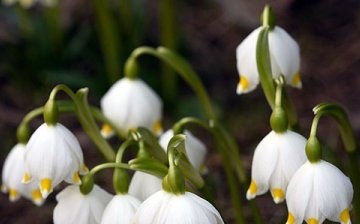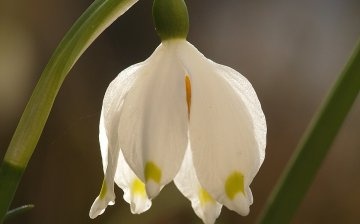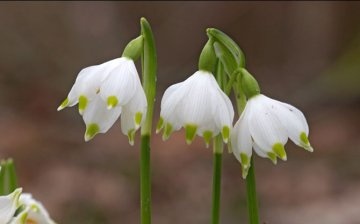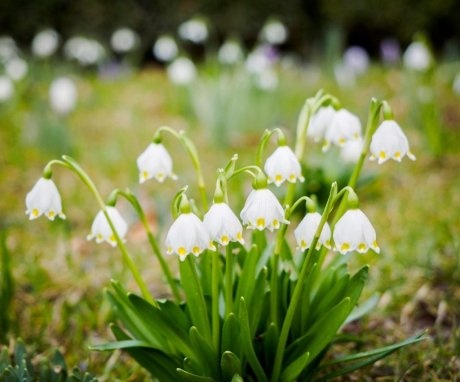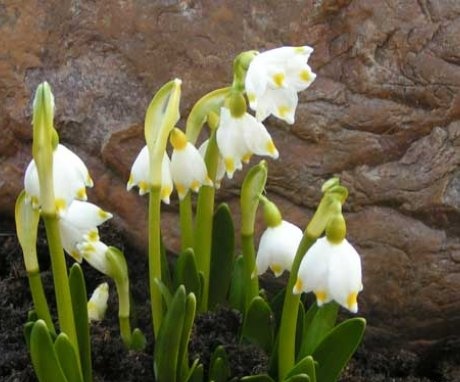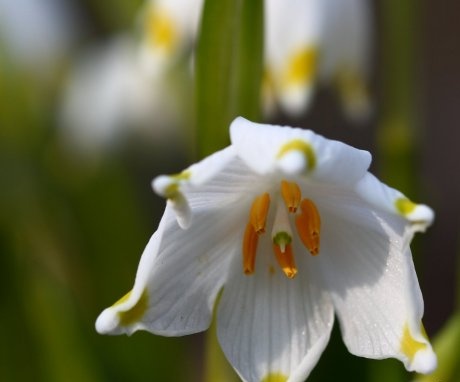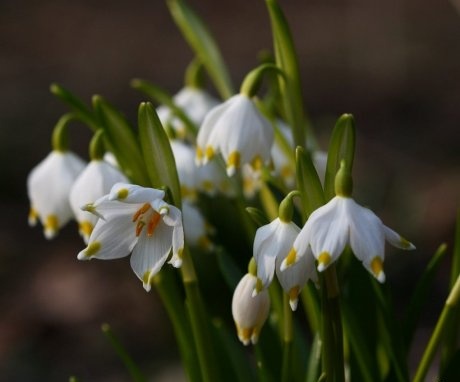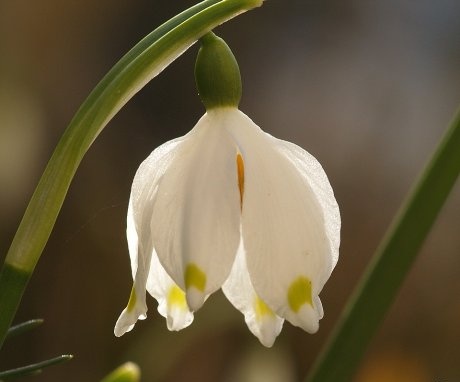How to properly grow a spring white flower?
Spring white flower belongs to perennial medicinal plants. It is often called the "white violet", but in appearance the white flower resembles a lily of the valley or snowdrop.
Content:
- Description and application of the plant
- Proper care and fit
- Reproduction of spring white flower
- Flower pest control
- Common diseases of the white flower
- The medicinal properties of the white flower
Description and application of the plant
The plant grows up to forty centimeters in height. It blooms in April, and the flowers themselves are small white bells with yellow specks. The birthplace of the white flower plant is considered to be Central Europe. The plant has many species, most of which do not grow in the Russian climate.
However, the spring white flower tolerates winter well and does not require preparation for the frosty period.
It is planted in a group of up to ten plants, since a single white flower looks rather boring and lonely because of its small size. A good solution would be to combine a white flower with plants that bloom a little later.
There are many ways to use a plant in landscaping:
- When decorating rocky gardens.
- When decorating borders.
- When decorating mixed flower beds.
- When making reservoirs.
Proper care and fit
Plant care tips:
- The soil. White flowers love soil saturated with humus. Also, the earth must pass water and oxygen well. To do this, you can dilute the soil with river sand or gravel. For greater nutritional value, rotted manure or peat diluted with lime is suitable.
- Plot. The plant loves shade, so for planting it it is worth choosing a place under the trees, away from the scorching sun rays. Also, the white flower will grow well near the reservoir. The white flower should be replanted every five years.
- Watering... The white flower loves moisture, and since active growth occurs in mid-spring, thawed snow usually satisfies the plant's need for watering. But if the white flower does not receive enough moisture during the flowering period, then it must be watered. Otherwise, the stems will be low, and the flowering will not be as active. However, after flowering and seed formation, the white flower does not require special care and watering.
- Fertilizer... Top dressing of the white flower is carried out with liquid inorganic fertilizers. It is best if the mixture contains potassium and phosphate. It is important not to overdo it with nitrogen fertilization, since with an excess of this substance, the plant can infect the fungus.
How to properly plant a white flower:
- The best time to plant a plant is from July to September. During this period, the plant is no longer in the phase of active growth and tolerates the planting procedure well.
- When buying, you should pay attention to the plant bulb. It should be heavy and solid. The shell of the bulb should not be damaged, overgrown roots and stems. The bulb may have shallow scratches, but it is important that they are free of mold. You do not need to take soft and wrinkled bulbs, this indicates rot, which makes the planting material unusable.
- In addition, you should not take a flowering plant as a planting material. Soon the flowers and foliage will dry out, and the bulb will take a long time to adapt in a new place. It is not a fact that you can expect flowering even next year.
- Purchased bulbs cannot be kept outdoors, otherwise they will dry out. It is necessary to sprinkle them with sawdust or put them in a bag.
- Planting is carried out to a depth equal to two bulbs, while the soil should be sufficiently loose.
Reproduction of spring white flower
White flowers can be propagated seeds, or in a vegetative way:
- The seeds usually ripen at the end of June. And they sow them immediately after they are harvested, or in the fall, since they cannot be stored. A good place to plant is in pots or crates. This is very convenient as the seedlings are small and can be lost. The planting containers are covered with plastic wrap. Such plants will bloom only after 6 years.
- White flower bulbs often form "babies" if planted in a shallow hole. Up to two small bulbs can form per season. Planting can begin five years later, after planting the mother bulb. You can fertilize plantings with mullein.
Flower pest control
The main pests that the owners of the white flower have to fight:
- Rodents. You can try to combat this pest by spraying the plants with a solution of mint essential oil, or a decoction wormwood, since mice and rats do not tolerate the smell of these plants. Planting imperial hazel grouse scares off rodents well. At the plantings of the white flower, you can decompose the foliage and stems of the elderberry, which is considered poisonous to rodents, and, accordingly, scares them away. Also, pests do not like smell. cilantro and pharmacy chamomile.
- A scoop butterfly. The fight against this pest is carried out in several stages: manual collection of larvae; fertilization of the roots of the white flower with potassium and superphosphate; spraying the plant with infusion from the tops potatoes, burdock and wormwood; use of insecticides.
- Slugs. The main methods for pest control include: manual collection of slugs; msoil cultivation needles or straw, so it will be extremely difficult for slugs to get to the plantings of the white flower; making dark beer traps that can be placed around the garden area; soil sprinkling ash, it sticks to the body of the slug and interferes with its movement; sprinkling clusters of pests with soda ash, from which slugs instantly die.
- Nematode... You can fight pests using the following methods: use of insecticides; heat treatment of the roots, which is quite risky for the white flower, because the plant does not suffer damage in root system... To carry out the processing, it is necessary to dig out a flower, clean the roots from the impurity of earth and lower it for a while in water at a temperature of 55 degrees Celsius.
- Thrips: use of insecticides; processing of bulbs with a solution with the addition of tobacco and mustard.
Common diseases of the white flower
Gray mold. The disease causes rotting of the bulbs and the aerial part of the plant. The result is a plant lag in development, leaf deformation and necrosis. How to fight:
- Provide good ventilation for plants. Thin the plantings in case of dense crowding.
- Spray the plants with a solution of ash, chalk and vitriol.
- Apply fungicides (Bordeaux liquid).
Rust. Capsules appear on the foliage, which crack over time and emit an orange powder, which contains the fungus. The plant begins to weaken and eventually dies. How to fight:
- Destruction of infected plants.
- Deep loosening of the soil.
- Fertilizing the soil with phosphorus and potassium.
- Application of fungicides.
Viral diseases (white streak). Red stripes appear on the foliage, which eventually turn white and merge.Such leaves dry up and die off, followed by the plant itself. How to fight: unfortunately, the only "treatment" of plants for viral diseases is the total disposal of all infected white flowers. It is best to do this as soon as possible, as viral diseases spread very quickly. In addition, all fallen leaves must be removed and burned to avoid re-infection.
- Chlorosis. The disease can be seen in the foliage, which begins to turn yellow as the plant itself weakens. The edges of the leaves curl, then they completely fall off. Further, the death of the root system and the death of the plant itself may occur. How to fight:
- Application of fungicides.
- Soil enrichment with iron.
- Watering the soil with acidified water.
A very interesting and unconventional method is to bury rusty nails or any other rusty metal objects in the ground. This method can be effective even when other means of struggle do not help.
The medicinal properties of the white flower
White flower has a fairly wide range of medicinal properties. Its stems contain galantamine, which is actively used by modern medicine in the treatment of paralysis. In addition, it is able to increase muscle tone and calm the nervous system. White flower tincture can be used for psychosis and various nervous disorders. Also, the white flower has a good expectorant effect.
However, it is important to remember that this plant is poisonous, therefore, its use requires special care.
The use of the white flower for medicinal purposes is contraindicated for persons suffering from epilepsy, asthma, angina pectoris and bradycardia, as well as for pregnant and lactating women with children.
Spring white flower is a truly unique plant that can not only decorate a personal plot, but also benefit health. Wide application in landscape design makes it especially attractive and desirable for gardeners.
More information can be found in the video:



